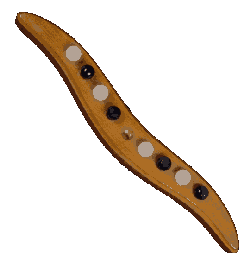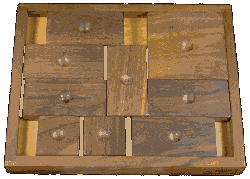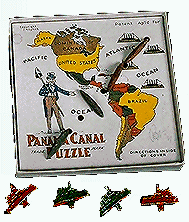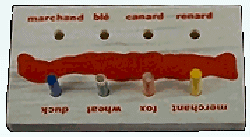Sometimes called Sequential Movement Puzzles, Jerry Slocum & Jack Botermans, (Puzzles Old and New, Seattle: University of Washington Press, 1992) explain that these puzzles are related to the "well-known" Solitaire or Peg Puzzles, and Rubick's Cube. The solution to each of these puzzles requires a user to follow a series of sequential movements within a set of strict rules in order to arrive at a predetermined result. Many puzzles of this type first appeared during the 18th and 19th century in Europe, often devised by mathematicians. The following are some examples from the collection.

Shuttle Puzzle: Purchased by the Museum in 1972 from Berea Student Craft Industries, Kentucky, this puzzle was described as early as 1883 by the mathematician Edward Lucas. Sometimes called the "hop-over puzzle", the board for this example is shaped like a weaving shuttle. It is 30.4cm long x 3.cm wide x 2cm thick, and made of cherry wood. There are 9 cup-like depressions in the board. The intent is to start with the 4 marbles of one color on each side, with an empty cup in the center, and then move the 4 from one side to the other side by following these rules - 1 marble may move 1 space or jump over 1 marble to an empty space - but a marble cannot back-up, or jump over 2 marbles. The solution requires 24 specific sequential moves. For a detailed solution to this puzzle click on the item in the left menu above.

Sliding Block Puzzle: Purchased by the Museum in 1972 from World Wide Games, Delaware, Ohio, this puzzle was first made popular in the 1870's by the mathematician Sam Loyd. The frame-box in this Museum copy is 20.4cm long x 16.5cm wide x 2.cm high. There are nine pieces of various sizes with cup-like depressions in each piece to enable a user to place a finger tip in the depression and easily slide a block in the frame-box. There are 6 rectangles, 2 small squares, and 1 large square. The puzzle begins with the pieces placed in a specific order, and the intent is to slide the pieces around until the large square is moved from the upper right side to the upper left side. Many colorful examples of this puzzle are pictured in Pieter van Delft & Jack Botermans, Creative Puzzles of the World, New York: Harry N. Abrams, Inc., 1978, pages 180-181.

Panama Canal: Donated to the Museum in 1983, but acquired by the donor many years earlier, this puzzle is similar to the "Red River", but the subject matter is the Canal, and the pieces are ships. The board (a map) is 12.8cm square with 9 holes placed diagonally across the board from the Pacific Ocean through the Canal to the Atlantic Ocean. There are 4 green and 4 red lead ships 3cm long x .6cm wide x 2.4cm high. The puzzle was made by B.J. Sturn Novelties, Detroit, Michigan. Puzzles such as this with other "map" themes first appeared early in the 19th century.

Crossing The Red River (or La Traversee Du Fleuve Rouge): Acquired in 1981, this puzzle was made by Rabanel Inc. Products in Canada. The wooden board is 7.6cm wide x 14.2cm long x 1.9cm thick. The colored pegs are 6cm in diameter x 3.6cm high, and represent a "merchant", a "fox", "wheat", and a "duck". On the reverse side of the board is a printed problem concerning how all of the characters might cross the river safely before meeting with disaster - i.e. the "fox" can eat the "duck", etc.
NOTE: This page was originally created and posted on the Web on October 6, 1997. Subsequently it has been modified and periodically updated. Last update April 11, 2010